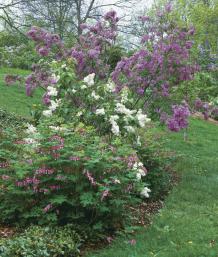
Sometimes it feels like I was destined to fall in love with lilacs. In my youth I spent countless hours working with my grandfather, a nurseryman who specialized in these enchanting beauties. I was most enthralled with a tall, pink-flowered ‘Esther Staley’ lilac that grew next to my grandparents’ back door. I once pollinated that plant in hopes of hybridizing a great new lilac, just as some dream of writing the great American novel. While my early attempt at hybridizing fizzled, I still breed lilacs as a hobby. Professionally, I also monitor the lilac collection at Harvard University’s Arnold Arboretum in Boston.
What makes lilacs so captivating? Certainly their enchanting fragrance heralds the arrival of spring. Lilacs are unique enough to define a color and a fragrance, and they’re remarkably easy to grow. And while lilacs used to come in just two flavors—purple and white—there’s now amazing variety in their color, habit, bloom size, shape, and flowering time.
These traditional plants are now used in many ways. Colorful and fragrant specimens can beckon attention. A grouping of lilacs can form a screen or hedge. Tall shrub or tree lilacs offer shade for a patio. Lilacs can also be underplanted with spring bulbs, or perennials such as bleeding heart (Dicentra spectabilis) that will bloom with them.
With lilacs, fragrance is the number one priority
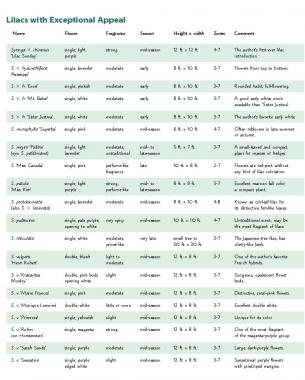
Some lilacs are more fragrant than others. For example, many white lilacs are only faintly scented. Other lilacs range from slightly sweet to highly pungent. I can detect the pleasantries of scent, but my olfactories seem to become quickly used to a smell. This makes it hard to distinguish the scents of different flowers. Still, when I smell lilacs, I smile.
Some years ago, I undertook a project to record which lilacs were—and were not—fragrant. I had to recruit volunteer sniffers. Now, based on the noses of others, I can confidently recommend fragrant lilacs.
French hybrids are the best-known lilacs
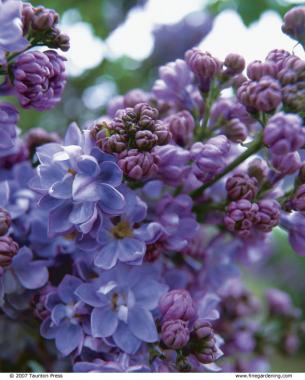
All lilacs belong to the genus Syringa, with about 20 species and hundreds of cultivars commonly cultivated. Most species are native to Asia. None are native to North America. Many of the species, or wild, lilacs look quite different from the popular common lilac, S. vulgaris, with its heart-shaped leaves and large flowers which bloom about the third week of May here in Boston.
Native to Eastern Europe, the common lilac was introduced to Western Europe before 1600 and likely to North America from there. It wasn’t until the 1800s that named cultivars were bred. Around 1900, so many of these better cultivars came from France that the term “French Hybrid” is often used to describe all cultivars of the common lilac, even though many were bred in other European countries or North America.
Beyond the common lilac, other Syringa species have some very interesting traits. All have pleasant fragrances, with some quite different from S. vulgaris.
The lilac usually considered the most fragrant is a Chinese native—S. pubescens. It has small, white flowers tinged with purple. The fragrance is sweet and spicy, very different from the traditional “lilac” scent.
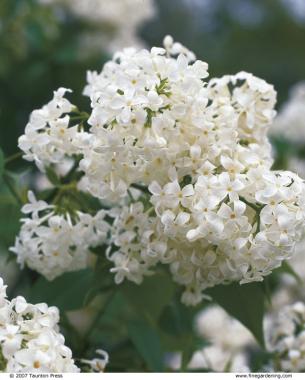
The early-flowering S. oblata, an attractive native of China and Korea, blooms about two weeks before the common lilac, which it resembles in looks and scent. This species is best known as a parent of the early-flowering hybrid group S. × hyacinthiflora. The other parent is the common lilac. Breeders have crossed S. oblata with cultivars of common lilac and created some fine early-flowering, fragrant selections, many of which are disease-resistant. My favorite cultivars come from this group. These include ‘Sister Justina’, my favorite white lilac, and the lovely lilac-pinks ‘Asessippi’ and ‘Excel’. None of these three have huge blooms, but all produce abundant flowers from the top of the plant to the ground. They are fragrant and, here in Boston, they seldom suffer from the prevalent foliar diseases—powdery mildew and leaf-roll necrosis.
Another Chinese species, S. protolaciniata (similar to S. × laciniata) is known as cut-leaf lilac because of its petite, deeply dissected, fernlike leaves. It produces many small, light-purple flowers in inflorescences that, unlike the common lilac, appear all along the stem from a branch terminal back about 18 inches. Some plants may become 8 feet high and 10 feet across, but it always has a very dainty appearance.
Some lilacs are trees
There are actually tree lilacs that are not simply big shrubs, but can become the size and shape of an apple tree. They make lovely shade trees and their dramatic bark adds a second season of interest. A large, unclipped hedge of tree lilacs, initially planted as a nursery row, now defines my backyard.
The tree lilacs flower a week to 10 days after the late lilacs, which flower about a month after the early lilacs. They have ivory blossoms that smell similar to privet, a close relative. The leaves of the Japanese tree lilac (S. reticulata) tend to be broader and rounder than those of the Chinese tree lilac (S. pekinensis). Both tree lilacs have attractive bark that is reminiscent of cherry bark, but that of the Chinese tree lilac often sheds, peeling off in strips. ‘China Snow’ is an attractive cultivar with this trait. ‘Ivory Silk’ is a cultivar of the Japanese tree lilac that is now commonly available. Beyond its value in gardens, it is showing promise as a small street tree.
A few are short and sweet
On each side of my front door, I have planted ‘Miss Kim’, a cultivar of S. patula. ‘Miss Kim’ is a compact shrub, but not a dwarf, growing to 8 to 9 feet tall and wide. One of the few lilacs with good fall color, its leaves turn a port-wine color. It flowers about a week after the common lilac, and displays many delightfully fragrant blooms.
Another compact lilac is the cultivar often called the ‘Dwarf Korean Lilac’. This lilac, S. meyeri ‘Palibin’, is in fact a dwarf, but it is a cultivar of a Chinese, not a Korean species. It has little, rounded leaves and small flowers on a plant seldom more than 4 to 5 feet tall. In bud, the flowers are a light purple, but when fully open they are white, abundant, and sweetly fragrant. This cultivar may be used to make a low hedge.
Late-blooming lilacs have a distinctive look and smell
The late lilacs bloom about a week to 10 days after the common lilacs. Most of them are the result of hybridizers having bred two or more species (as compared to breeding within a species) and selecting the best progeny. Isabella Preston, a Canadian plant breeder, first crossed S. komarowii ssp. reflexa and S. villosa to create the hybrid group S. × prestoniae. Others have gone on to cross the Preston lilacs with other late-flowering species. But these late-flowering lilacs don’t look or smell like what most people expect a “lilac” to be. Frankly, I think that if these shrubs were called by some other name, they would be more popular. Some of my favorites include ‘Miss Canada’, a real red-pink lilac, and ‘Agnes Smith’, with white flowers.
Lilac flowers range from creamy shades to purples
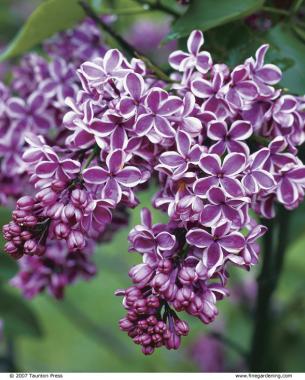
I’m partial to purple, but I grow lilacs of many colors and shades—lilac, white, blue, purple, magenta, violet, and pink. There’s even a yellowish lilac—S. vulgaris ‘Primrose’. It’s not the color of dandelions, but rather a luscious creamy yellow. Another unique cultivar is S. vulgaris ‘Sensation’; its purple flowers have a white pinstripe around each petal. Next to my back door, I planted a tall, narrow lilac, one of the Russian introductions of the common lilac called ‘Krasavitsa Moskvy’. Its opening buds remind me of pink opals which then become double, white flowers.
Lilac flowers commonly have four petals, but hybridizers have also developed many double-flowered cultivars. These have more than four petals per flower, often 12 or more. Sometimes these are arranged hose-in-hose, which means there’s a four-petaled flower within a four-petaled flower. Some of the newer introductions have the additional petals arranged radially—daisylike—all in the same plane.
What should one look for in a lilac? Attractive blooms, of course. More than that, flowers should be fragrant and abundant, and available in a favorite color. And disease resistance is a big plus.
Years ago, my favorite lilacs were those with large flowers. I’ve since realized that even the largest lilac flowers are only obvious from a few feet away and that most lilacs will be viewed from across a garden or even a street. Abundance of bloom then becomes very important, as does presentation. If all of your plant’s blossoms are at the top, you may have to sniff your lilacs from a second-story window. Many lilac cultivars become so tall that they’re not suitable for a single-story home.
Lilacs are easy to grow
Lilacs are as easy to grow as vegetables. And their needs aren’t all that different. Lilacs do best in full sun, and in well-drained, good garden soil with a pH that is neutral to slightly alkaline. They’ll tolerate less than the ideal in these categories, but floral rewards are directly related to meeting the plant’s needs.
Traditionally, lilacs are considered cold-climate plants. Most are hardy from USDA Hardiness Zones 3 to 7, so when climate is a concern, it’s about a lilac’s heat tolerance. There’s hope on the horizon for gardeners in warm climates. Recent selections bred at Descanso Gardens in Los Angeles do tolerate the heat and the lack of a chilling period. And lilacs grow on the campus of the University of California at Riverside. I’m told that one of the best cultivars there is my old favorite, the early-flowering S. × hyacinthiflora ‘Excel’.
When trimming or pruning lilacs, be sure to remember that the flower buds are formed the summer before they bloom. Pruning in winter almost always results in fewer blooms the following spring. To encourage the most flowers, prune lilacs right after their blooms fade.
Powdery mildew is a fungus that often grows on the leaves of lilacs, especially in humid areas. It’s usually more a nuisance than a threat, since it appears in the late summer and early autumn, after most of the growing season. It can be controlled with applications of fungicides, but I recommend growing those that are the least affected. Plants recommended in this article have exhibited only light to moderate symptoms of foliage diseases. However, site and climate also affect the likelihood of infection.
Leaf-roll necrosis, another foliar disease, is apparently caused by air pollution and may appear even hundreds of miles downwind of major cities. As with mildew, symptoms usually appear late in summer and in autumn. The leaf margins often die and turn brown and each leaf curls upward. Symptoms can be so unsightly that it may look like the plant will die. Fortunately, lilacs have done most of their growing by then and new spring leaves are usually healthy. Again, cultivars react with varying degrees of damage, so look for those that hold their beauty all season.
Fine Gardening Recommended Products

Felco Pruning Shears (F 9) - High Performance Swiss Made One-Hand Left-Handed Garden Pruners
Fine Gardening receives a commission for items purchased through links on this site, including Amazon Associates and other affiliate advertising programs.

Spear & Jackson 4930FZ Razorsharp Telescopic Tree Pruner
Fine Gardening receives a commission for items purchased through links on this site, including Amazon Associates and other affiliate advertising programs.

Ho-Mi Digger - Korean Triangle Blade
Fine Gardening receives a commission for items purchased through links on this site, including Amazon Associates and other affiliate advertising programs.


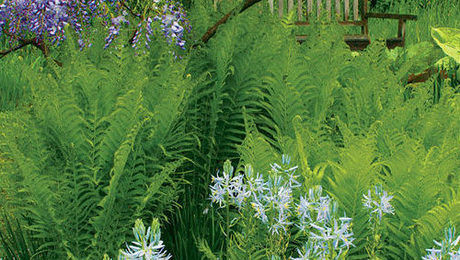
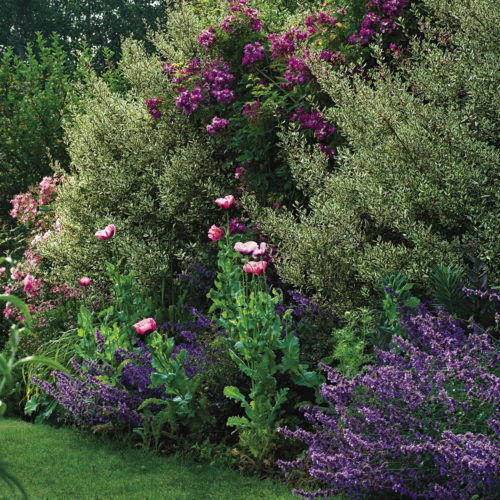
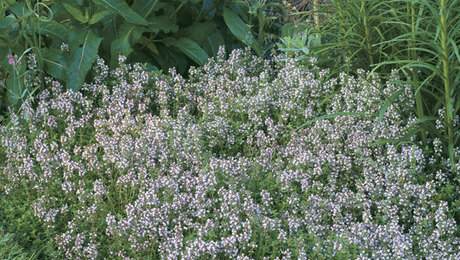













Comments
Interesting article. It would be more significantly more useful if the trial data (chart) were legible. Alas, this is appears to be the normal resolution for FG online.
Log in or create an account to post a comment.
Sign up Log in